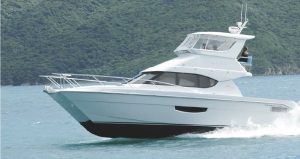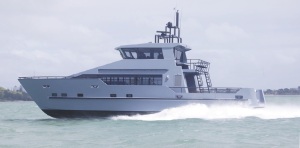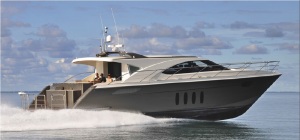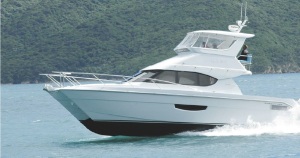It is fair to say that by now, most people out there with any kind of interest in boats at all will have a pretty good understanding of what ‘foils’ are and what ‘foiling’ is. This was illustrated very graphically for day after (painful) day last September as our screens were filled by the fantastic sight of two 72’ wing powered America’s Cup sailing cats blasting around San Francisco Bay on hydro-foils at speeds that a few power boaters can relate to, but probably not too many yachties.

The word ‘foil’ actually has a number of meanings and I was delighted to hear America’s Cup TV commentator and sailing legend Chris Dickson deadpan the expression “foiled by the fickle finger of fate” as race 13 was abandoned when the 40 minute time limit was reached, depriving Emirates Team New Zealand of the America’s Cup by a matter of only a few minutes
I had always heard a slightly modified, but less publishable version of the epithet, but being foiled in a competition that relies so heavily on a different kind of foil to achieve sheer, outright speed does have a certain symmetry to it…
So we know that foils can be used to make boats ‘fly’ above the water, but in technical terms, what is a ‘foil’? Leaving aside swords, very thin sheets of aluminium used to wrap food in and the verb for thwarting someone or something, a foil is basically what most people would call a ‘wing’ – and is the technical term for a lifting body that generates force on one side due to the flow of a fluid past that body. The fluid can be gas or liquid – air or water – and the density of the fluid, the speed with which it flows over the foil, the shape of the foil and the angle of attack (the angle at which the fluid flow meets the foil) all dictate how much lifting force it can generate – and how much drag is also produced.
Even a flat plate can be a lifting body although it needs to be at an angle to the air or water flow to generate lift; more complex foils are shaped such that air or water has to flow faster over one side than the other. Although fluid dynamics experts will probably frown at the following explanation, this velocity difference causes a higher pressure on one side of the foil and a significant lower pressure on the other – generating a net lifting force.
This principle is put to good use in a myriad of applications from aircraft and propellers, to turbines and rudders. If you have a flow of fluid and can place a foil in it, you can generate useful forces from the energy associated with that flow. The towering AC72 wing sail is a collection of air foil elements that generates lift and thus a propelling force as the wind flows over it.

The hydro foils are wings that move through the water due to the driving force generated by the wing sail and in turn, generate hydro dynamic lift, picking the boat up and (mostly) out of the water to reduce the drag associated with moving the hulls through the water. So why put a hydrofoil on a boat in the first place?
Well, whether you are dragging a displacement or a planing hull through the water, there is a great deal of resistance associated with the combination of skin friction (wetted surface area) and wave making drag. On displacement mono-hulls, wave making drag tends to dominate, because the hull is essentially always supported by buoyant forces rather than by any kind of dynamic lift, so pretty much the same amount of hull remains in the water throughout the speed range as it does when the boat is stationary. Displacement mono-hulls in particular tend to be slow boats, limited to how fast they can go as a function of their ‘hull speed’ – usually defined (in knots) by the square root of the water line length (in feet) multiplied by a constant – usually between 1.3 and 1.5. Thus, a displacement hull with a waterline length of 30 feet can be expected to top out at around 7.5 knots. You can make a displacement hull move faster than hull speed but you will need to generate some dynamic lift to reduce drag caused by wave making and wetted area, so often a fast sailing yacht hull will be light and will have a flat run in it’s aft sections to promote lift.
Conventional fast powerboats generally use the planing hull form that most of us are familiar with. This is characterized by flat bottom shell surfaces bounded by down angled and sharp cornered chines – often with flat keel planks and strakes to add lift and control spray. And, usually with more or less deadrise angle to reduce slamming, particularly on smaller planing hulls. There are some great photos on the internet of upside down tables (ie a planing surface with zero deadrise angle!) with an outboard motor clamped to one end that look to be planing beautifully. These flat plane hull shapes are intended to promote lifting forces as the speed of the boat increases, although rather than generating lift due to low pressure on an upper surface, it can only create lift by deflecting oncoming water downwards. For every action there is an equal and opposite reaction, so by deflecting the water flow downwards, a reaction force is generated that pushes the boat upwards.
Removing hull area from the water reduces drag or resistance – and that allows the boat to increase it’s speed. Making boats go fast is really about adding power and reducing drag, so getting as much boat out of the ‘sticky’ water as possible is very desirable. Of course you still need something in the water to push the boat along and steer it – otherwise you become an airplane – but raceboats at really high speed often have only a very small portion of the hull, plus the drive skeg and propeller in the water. And, when their angle of attack becomes too great, they can turn – briefly – into an airplane…

Generating planing lift off one side of a flat plate by deflecting the flow downwards is not a terribly efficient way to generate lift – the associated drag remains quite high, so in some – but not all situations – it is logical to look at using more efficient, low drag foils to generate that lift instead. Are foils on boats anything new? If you consider that the first proper boats were launched by their proud builders many thousands of years ago, then the advent of hydro foils on boats is fairly recent.
That said, in the years that the Wright brothers and Richard Pearse were experimenting with air foils in their attempts to fly, Italian Enrico Forlanini and Briton John Thorneycroft were both successfully doing the same with hydro-foils.
By late 1919, Alexander Graham Bell (of telephone fame) had set a world water speed record of just under 71mph in the twin 350hp powered, foil borne HD4. So hydro foils have actually been with us for quite some time and seen action in a number of different applications. Spectacular though the AC72s may have been while flying around San Francisco bay – and, while putting foils on an America’s Cup yacht might be new and radical, plenty of boats – both power and sail, big and small have done it all before.
For example, in the 90s and early 2000s, legendary French sailors Alain Thébault and Eric Tabarly designed, built and sailed the amazing 18m foil borne trimaran ‘Hydroptere’ into the record books, achieving nearly 53 knots under sail in 2008, breaking the speed record over 500m at the same speed in 2009 and briefly touched 56 knots. Before crashing, admittedly. This however, is one sail boat that might just leave an AC72 in it’s wake…
At the other end of the scale, the International Moth is a small sailing dinghy – a development class – that has embraced hydro-foils in recent years, achieving speeds in the order of 30 knots flying on impossibly thin wands – and creating interest that has seen hydro-foils fitted to Lasers and Hobie 16s. Given the recent exposure with the America’s Cup, it is entirely possible that we will see some foiling 8.5m class catamarans breaking records in future ‘Coastal Classic’ yacht races, providing Cat 3 race safety requirements don’t get in the way.
Foiling in powerboats
The military were early adopters of hydrofoil technology in power boats and Canada worked on an experimental smoke laying hydrofoil during World War II. Between the early 1950s and early 1990s, the US, Soviet and Italian Navies all developed hydrofoils for torpedo boat, missile boat and patrol applications, some of which remain in active service today.
Youtube is a treasure trove of footage of these boats and there is a great old documentary online about the US development of Navy hydrofoils that is well worth a watch if you have read this far. There is something quite fascinating about watching a seriously big Navy ship climbing out of the water in stately fashion and flying over the waves, before settling off the foils and back into the water in very dignified matter. There is also footage of smaller hydrofoils in heavy seas and although they at times glide serenely over the waves, it gets very wet, very quickly when the hull briefly touches down in the face of an oncoming swell.
Passenger craft hydrofoil development was also strong during this post war period with the Soviets being particularly prolific, building large numbers of foil borne ferries – chiefly for long distance operation on their inland waterways, but also for export to countries all over the world. Aircraft manufacturer Boeing also dabbled with hydrofoils, looking to take it’s expertise in production manufacturing of aircraft into the passenger ferry market with the Boeing 929 Jetfoil.
Typically, the US and Soviet approaches differed – the Americans favouring full submerged foils that required complex control systems to operate and the Soviets using a more robust, simplistic surface piercing foil system that automatically regulates altitude, pitch and roll without fancy electronics and moveable control surfaces. Even today, fast hydrofoils operate for thousands of miles along inland water ways in the former Soviet territories, sometimes offering the only viable fast passenger transport service.
In the post war years, German was prohibited from building fast boats, so a German engineer named Hanns Von Schertal – who worked on hydrofoil design before and during World War 2 – set up Swiss company Supramar, which was one of the first passenger ferry hydrofoil designers.
Built by Rodriquez, the Supramar PT20 Manu Wai foiling ferry was delivered into service between Waiheke Island and Auckland in 1964 where it operated for nearly 10 years. Later, Manu Wai saw intermittent service as a charter vessel between layups – and a misadventure with a mud bank that saw the foils badly damaged – before shipping across the Tasman to Sydney, where she resides today, still in working condition.
Many of the early mono-hull hydrofoils remain in service today; ride qualities in rough seas can be superb and fuel efficiency can be excellent, so hydrofoils remain a common sight in places such as Hong Kong. However they are technically complex, expensive to build, vulnerable to damage and expensive to maintain, particularly when complex mechanical systems are required for propulsion and to retract the foils so that the vessel can berth and traverse shallow water.
An associate of mine was involved in the early 1990s with the construction of a foil borne catamaran ferry in Sweden. The boat was delivered to Indonesia, where it operated successfully and efficiently until one of the custom built water jet intake ducts located in a foil strut was hit by a floating log, putting the ferry out of action for 3 months while a (hellishly expensive) replacement part was constructed and shipped from Sweden. In the meantime, the operator went broke, because their chief source of revenue was no longer operable and thus no longer making money for them.
The development of the assist foil
For reasons such as this, ageing hydrofoil fleets have yielded in the last few decades to simpler, less costly catamarans. And that in turn has lead to development of a more subtle, less visible, but nonetheless very effective type of hydrofoil – the assist foil. Developed by Professor Gunter Hoppe and his team at Stellenbosch University, South Africa in the 1970s, the “Hysucat” or Hydro Foil Supported Catamaran employs an assist foil that is intended to partially foil support the boat.

Rather than lifting all of the hulls clear of the water – necessitating expensive drivelines – Hoppe’s foil spans between the two catamaran hull forms and is located close to or above the keel line of the two demi hulls, thus reducing vulnerability to grounding or impact with floating objects. This system tends to use a main foil located at or just forward of the longitudinal centre of gravity and is often locked at a fixed angle.
On more complicated installations, the angle of attack can be adjusted to vary the lift and drag offered by the foil. A much smaller trim foil (or foils) is then located near the stern of the catamaran and again, this/these can be set up at a fixed angle, or can be adjustable to vary the trim angle of the boat and thus the angle of attack of a fixed main foil. Generally this system is designed to carry approximately half the displacement of the vessel at maximum speed. The driveline remains immersed, so conventional propulsors can be used, keeping cost down and generally significant improvements in fuel burn can be achieved for a given service speed by fitting a foil to a fast catamaran – a very worthwhile saving if you are ferry operator. And, because the dynamic lift from the foil raises the catamaran higher in the water than it might normally operate, slamming on the tunnel roof can be reduced, offering notable improvements in ride quality in many instances. This Hysucat system was patented by Stellenbosch University – although not globally – and the patent has since expired, so assist foils have been adopted around the world on catamarans, including a number of commercial ferries, designed, built and operating here in New Zealand. So how relevant is all this to pleasure boating in power boats?
Well, the key benefits of partial or complete foil support are sea kindliness and fuel efficiency – so both are of interest to typical pleasure power boaties with a 10 – 24m motor boat – and generally this is why we have either specified or retro-fitted assist foils on a number of cataramans we have been involved with in the past.
Retro-fitting foils is a great way to gain an understanding of the benefits that can be gained, because diesel fuel burn data gained during sea trials pre and post fitting of the foil clearly demonstrates the effect of the foil. Our experience has shown that assist foils can offer significant improvements – up to 18% reduction in fuel burn at cruise in some instances and increases in speed from 30 knots without foils to 38 knots with them. For the relatively modest cost involved, there probably aren’t any other comparable mechanisms to achieve such a gain, although you do need to be doing reasonably big mileage before the fuel savings justify the investment.
There is some potential to fit assist foil to planing mono-hull pleasure boats – and of course, even to fully foil support them, just as has been achieved with ferries and military craft. There is some great footage of a 24’ Bayliner owned by ex-Boeing engineer Harry Larsen, who designed and installed the foils – and importantly, the systems required to keep the boat at constant altitude and to control roll, yaw and pitch. Larsen’s original system used a simple mechanical system involving a ski that skims the surface of the water and is connected to the forward foil pitch controller to maintain ride height – and this system is commonly used on the foiling Moths mentioned earlier. The later system uses electronic control systems and hydraulics to alter foil pitch.
But why hasn’t the world embraced hydro-foils more? Shouldn’t we all have one?
Plenty of people are interested in Larsen’s flying Bayliner – there are nearly 1 million views on Youtube – but he has never had enough inquiry about the foil system to make production viable for retro-fit – and as he wryly notes on his website – no-one ever asked him if they could buy the boat. Maybe pleasure boaters are just too conservative, or maybe the risks and downsides really do outweigh the positives. America’s Cup 2013 is bound to have renewed interest in foils and foiling, so a boom in foiling sail boats could well be on the cards.

Certainly the number of foil assisted catamarans on the market – at least the faster ones – are on the rise, probably because they are simple, robust and reliable and offer significant benefits for reasonable cost. And that is really the key, particularly when most of the world’s power boat pleasure boating happens in mono-hulls. If fully foiling mono-hulls isn’t practical or desirable, perhaps the next big thing in pleasure boating will be the assist foil for mono-hull power boats? Watch this space…




